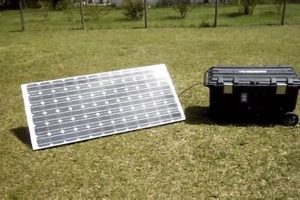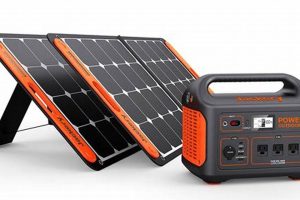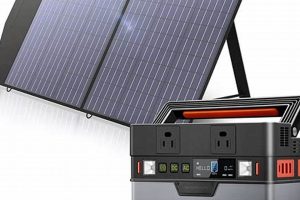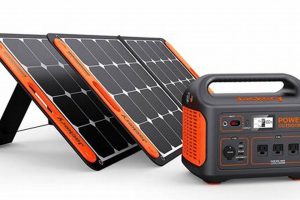A self-contained unit combining photovoltaic panels, a battery, and an inverter provides off-grid electricity. This setup captures sunlight, converts it into usable power, stores it for later use, and offers a clean alternative to traditional fuel-powered generators. Imagine a campsite powered by the sun, or a home maintaining essential functions during a grid outage this technology makes such scenarios possible.
The ability to generate electricity independently of the power grid offers significant advantages, particularly in emergency preparedness, remote area power supply, and environmentally conscious energy consumption. Historically, reliance on fossil fuels for portable power generation has presented environmental and logistical challenges. This technology represents a significant step towards cleaner and more sustainable power solutions.
The following sections will delve into the core components, functionalities, various applications, and selection criteria for these independent power solutions. Further discussion will cover practical considerations such as sizing, maintenance, and safety protocols.
Practical Considerations for Off-Grid Power Solutions
Careful planning and execution are essential for maximizing the effectiveness and longevity of independent power systems. The following tips offer valuable insights for practical implementation.
Tip 1: Accurate Power Needs Assessment: Before selecting a system, calculate total energy consumption requirements. Consider the wattage of devices and their anticipated usage duration. Overestimating ensures sufficient power availability, while underestimation can lead to system overload or insufficient runtime.
Tip 2: Panel Placement and Orientation: Optimal sunlight exposure is crucial for efficient charging. Panels should be positioned in direct sunlight, ideally facing south in the northern hemisphere, and adjusted seasonally for optimal performance. Obstructions such as trees or buildings should be minimized.
Tip 3: Battery Capacity and Lifespan: Battery capacity dictates the amount of stored energy available. Consider the desired runtime and power demands. Battery lifespan is affected by usage patterns and environmental factors; appropriate charging and maintenance practices can extend battery life.
Tip 4: Inverter Selection and Compatibility: Inverters convert DC electricity from the panels and battery into AC power for most household appliances. Ensure the inverter’s output wattage and voltage match the requirements of the intended devices.
Tip 5: Charge Controller Functionality: A charge controller regulates the flow of electricity from the panels to the battery, preventing overcharging and optimizing battery health. Selecting an appropriate controller type (MPPT or PWM) is critical for system efficiency.
Tip 6: System Maintenance and Monitoring: Regular inspection and maintenance are essential for optimal performance. This includes cleaning the panels, checking connections, and monitoring battery health. Proactive maintenance can prevent costly repairs and extend the system’s lifespan.
Tip 7: Safety Precautions and Protocols: Working with electrical systems requires adherence to safety guidelines. Proper grounding, circuit protection, and safe handling procedures are crucial to mitigate potential hazards.
By adhering to these guidelines, users can ensure efficient, reliable, and safe operation, maximizing the benefits of their off-grid power solution.
The concluding section will summarize the key advantages and potential future developments in this rapidly evolving field.
1. Portability
Portability is a defining characteristic of these systems, differentiating them from fixed solar installations and enabling diverse applications previously unattainable with traditional power sources. This feature allows for convenient transportation and deployment in various scenarios, expanding the possibilities of off-grid power generation.
- Compact Design and Lightweight Components:
Modern systems utilize lightweight materials and integrated designs, minimizing bulk and weight. Foldable solar panels and compact battery units contribute to overall portability. This allows individuals to easily transport the system in vehicles or even carry it by hand to remote locations, such as campsites or disaster relief areas.
- Integrated Handles and Wheels:
Many units incorporate features like carrying handles and integrated wheels, further enhancing portability. These design elements facilitate easy movement and maneuverability across various terrains. For example, relief workers can quickly deploy a system in a disaster zone without requiring specialized equipment or vehicles.
- All-in-One Systems:
Integrating all essential componentssolar panels, battery, inverter, and charge controllerinto a single unit simplifies setup and reduces the need for complex wiring or external components. This streamlined design enhances portability and ease of use, especially in time-sensitive situations.
- Adaptability to Various Environments:
Portable systems are designed to function effectively in diverse environments, ranging from remote wilderness areas to urban settings during power outages. This adaptability makes them valuable tools for various applications, from recreational activities to emergency preparedness. For instance, a portable system can power essential appliances during a camping trip or provide backup power during a grid failure in a residential area.
The portability of these systems significantly expands the accessibility of off-grid power, enabling users to generate electricity wherever and whenever needed. This feature unlocks new possibilities for remote work, recreational activities, emergency preparedness, and sustainable living, marking a significant advancement in power generation technology.
2. Renewable Energy
Renewable energy forms the core of solar portable generator systems. These systems leverage solar energy, a clean and abundant resource, to generate electricity without depleting finite resources or producing harmful emissions. This reliance on solar energy directly addresses growing concerns about climate change and the environmental impact of traditional fossil fuel-based power generation. The conversion of sunlight into electricity through photovoltaic panels eliminates the need for fuel consumption, reducing carbon emissions and promoting a cleaner environment. For example, utilizing a solar portable generator system for off-grid power in remote areas avoids the need for diesel generators, significantly reducing air pollution and noise pollution. This shift toward renewable energy sources plays a crucial role in mitigating climate change and promoting sustainable practices.
The utilization of renewable energy in these systems offers several advantages beyond environmental benefits. It reduces dependence on fluctuating fuel prices and supply chain disruptions, ensuring energy independence and price stability. This independence is particularly valuable in remote locations or during emergencies when access to traditional power grids is limited or unavailable. Furthermore, the continuous replenishment of solar energy provides a sustainable and reliable power source for extended periods, unlike finite fossil fuels. For instance, in disaster relief efforts, solar-powered systems can provide consistent power for essential services like communication and medical equipment without requiring fuel resupply, which can be logistically challenging in disaster-stricken areas. This reliability makes these systems a practical and sustainable solution for long-term off-grid power needs.
The integration of renewable energy sources into portable generator systems marks a significant step toward sustainable and accessible power generation. While challenges such as weather dependency and initial cost remain, the long-term benefits of reduced environmental impact, energy independence, and cost stability position these systems as a crucial element in the transition to a cleaner and more sustainable energy future. Addressing these challenges through ongoing technological advancements and supportive policies will further enhance the accessibility and effectiveness of these systems, promoting wider adoption and contributing to a more sustainable energy landscape.
3. Off-Grid Power
Off-grid power capabilities represent a defining characteristic of solar portable generator systems, enabling operation independent of traditional power grids. This independence offers significant advantages in various scenarios, including emergency preparedness, remote area power supply, and sustainable living. These systems empower users to generate and utilize electricity in locations lacking grid infrastructure or during grid failures. For example, during natural disasters, a solar portable generator system can provide essential power for communication, lighting, and medical devices, ensuring continuity of critical services when grid power is unavailable. This capability is crucial for disaster relief efforts and enhances community resilience.
The off-grid functionality of these systems is particularly valuable in remote areas where extending grid infrastructure is impractical or cost-prohibitive. Applications range from powering remote research stations and telecommunications equipment to providing electricity for off-grid homes and cabins. This facilitates economic development and improves living standards in remote communities while minimizing environmental impact. Furthermore, off-grid power solutions support sustainable living practices by reducing reliance on fossil fuels and promoting energy independence. For instance, individuals embracing off-grid lifestyles can utilize these systems to power their homes, reducing their carbon footprint and promoting self-sufficiency.
The ability to operate independently of the grid positions solar portable generator systems as versatile and resilient power solutions. This off-grid functionality plays a crucial role in disaster preparedness, remote area development, and sustainable living, offering significant practical advantages and contributing to a more resilient and environmentally responsible energy landscape. While challenges such as weather dependency and initial costs exist, ongoing technological advancements and policy support continue to enhance the accessibility and effectiveness of these systems, fostering wider adoption and promoting a more decentralized and sustainable energy future.
4. Emergency Preparedness
Emergency preparedness necessitates reliable access to power, especially when conventional grids fail. Solar portable generator systems offer a crucial solution, providing essential electricity during unforeseen events. These systems empower individuals, communities, and emergency responders to maintain critical operations, enhancing resilience and minimizing disruptions. The cause-and-effect relationship is clear: natural disasters or grid failures cause power outages; these systems mitigate the effects by providing backup power. For example, during hurricanes or earthquakes, these systems can power essential communication devices, medical equipment, and lighting, enabling continued access to vital resources and facilitating rescue and recovery efforts.
Emergency preparedness as a component of owning a solar portable generator system significantly influences system design and functionality. Considerations include battery capacity, power output, portability, and ease of use. Systems intended for emergency use often prioritize features such as rapid charging capabilities, multiple power outlets, and durable construction. These design choices reflect the practical needs of emergency situations, ensuring reliable power availability when it matters most. For instance, a system designed for emergency preparedness might feature a higher battery capacity to provide extended power during prolonged outages, as well as weatherproof construction to withstand harsh environmental conditions.
Understanding the practical significance of this connection empowers individuals and communities to enhance their preparedness strategies. Investing in a solar portable generator system represents a proactive step toward mitigating the risks associated with power outages. This preparedness can significantly impact safety, well-being, and the ability to navigate emergencies effectively. While initial cost considerations exist, the potential benefits of enhanced resilience, reduced reliance on strained resources, and improved safety outcomes during critical events underscore the long-term value of integrating these systems into emergency preparedness plans. Furthermore, advancements in technology and decreasing costs are making these systems increasingly accessible, promoting wider adoption and enhancing community-level preparedness.
5. Quiet Operation
Quiet operation distinguishes solar portable generator systems from traditional fuel-powered counterparts. Conventional generators often produce significant noise pollution, disrupting surroundings and creating an unwelcome disturbance. Solar-powered systems, relying on photovoltaic conversion and battery storage, operate silently or with minimal noise output. This characteristic is particularly valuable in noise-sensitive environments such as residential areas, campsites, and during disaster relief efforts. Cause and effect are evident: traditional generators cause noise pollution; solar generators effect noise reduction. For instance, in a residential setting during a power outage, a solar generator allows for continued power supply without the intrusive noise of a gasoline generator, maintaining a peaceful environment and minimizing disruption to neighbors.
The quiet operation of these systems is a crucial design element, significantly influencing user experience and practical applications. This characteristic expands the range of suitable applications, permitting use in settings where noise restrictions apply or a quiet environment is paramount. Consider a film crew powering sensitive equipment in a remote location; the silent operation of a solar generator prevents noise interference with recording equipment. Similarly, in healthcare settings or disaster relief operations, minimizing noise pollution is essential for patient comfort and effective communication. This feature enhances the versatility and practicality of solar portable generators, making them suitable for a broader range of applications compared to noisy alternatives.
Recognizing the significance of quiet operation highlights a key advantage of solar portable generator systems. This feature contributes to improved quality of life, environmental preservation, and enhanced functionality in diverse applications. While challenges such as weather dependency and initial cost remain considerations, the benefits of noise reduction extend beyond mere convenience, impacting health, productivity, and environmental harmony. Further technological advancements and increasing affordability will continue to promote wider adoption, leading to quieter and more sustainable power solutions across various sectors, ultimately contributing to a more peaceful and environmentally conscious world.
6. Reduced Emissions
Reduced emissions represent a critical advantage of solar portable generator systems, directly addressing environmental concerns associated with traditional power generation methods. These systems offer a cleaner alternative, minimizing the release of harmful pollutants and greenhouse gases into the atmosphere. This characteristic is pivotal in mitigating climate change and promoting environmental sustainability. The shift toward cleaner energy sources is essential for preserving air quality and reducing the environmental impact of human activities.
- Air Quality Improvement
Traditional fuel-powered generators emit pollutants such as nitrogen oxides, particulate matter, and carbon monoxide, contributing to air pollution and respiratory health issues. Solar portable generator systems produce no such emissions during operation, significantly improving local air quality. In urban environments or disaster relief settings, where air quality can be compromised, this characteristic is particularly beneficial for public health. For example, utilizing solar generators in densely populated areas during power outages minimizes air pollution, protecting vulnerable populations from respiratory distress.
- Greenhouse Gas Reduction
The combustion of fossil fuels in traditional generators releases greenhouse gases, primarily carbon dioxide, which contribute to climate change. Solar generators utilize a renewable energy source, eliminating greenhouse gas emissions during electricity generation. This reduction in carbon footprint is essential for mitigating the long-term effects of climate change. For instance, replacing diesel generators with solar-powered alternatives in off-grid applications significantly reduces carbon emissions, contributing to global efforts in combating climate change.
- Environmental Preservation
Reduced emissions from solar portable generators contribute to broader environmental preservation efforts. Minimizing air and noise pollution protects ecosystems and wildlife, preserving biodiversity. Furthermore, reduced reliance on fossil fuels lessens the environmental impact associated with fuel extraction, transportation, and processing. For example, using solar generators in national parks or protected areas minimizes environmental disruption, preserving the natural ecosystem. This alignment with sustainable practices enhances environmental stewardship.
- Sustainable Development
The reduced emissions profile of solar portable generators aligns with sustainable development goals. These systems promote clean energy adoption, reduce environmental impact, and enhance community resilience, contributing to a more sustainable future. For instance, deploying solar generators in developing countries can provide access to electricity without contributing to air pollution or increasing carbon emissions, supporting sustainable development initiatives. This fosters economic growth while minimizing environmental degradation.
The reduced emissions of solar portable generator systems offer substantial environmental benefits, mitigating air pollution, reducing greenhouse gas contributions, and promoting sustainable practices. These advantages position these systems as environmentally responsible alternatives to traditional power generation methods, playing a crucial role in addressing climate change and fostering a more sustainable future. As technology advances and costs decline, the broader adoption of these systems will contribute to a cleaner and healthier environment for present and future generations. Furthermore, ongoing research and development efforts focus on enhancing the efficiency and affordability of these systems, accelerating the transition towards a more sustainable energy landscape.
Frequently Asked Questions
Addressing common inquiries regarding independent solar power solutions provides clarity and facilitates informed decision-making.
Question 1: What differentiates these systems from conventional gasoline generators?
Key distinctions include the utilization of renewable solar energy versus fossil fuels, resulting in significant environmental benefits. Operational noise levels differ substantially, with solar solutions operating much more quietly. Fuel costs and refueling requirements are eliminated with solar power. However, solar systems require sufficient sunlight for optimal performance.
Question 2: How is battery lifespan determined and maintained?
Battery lifespan depends on factors like usage patterns, charging cycles, and environmental conditions. Proper charging practices, avoiding extreme temperatures, and regular maintenance can significantly extend battery life. Consulting manufacturer guidelines for specific recommendations is essential.
Question 3: Can these systems power all household appliances?
The power output capacity dictates the types and number of appliances a system can support simultaneously. Wattage requirements of appliances must be considered. Larger systems can power more demanding appliances, while smaller systems are suitable for essential devices or smaller loads.
Question 4: What are the typical maintenance requirements?
Routine maintenance includes keeping solar panels clean, inspecting wiring and connections, and monitoring battery health. Specific maintenance schedules vary depending on the system and manufacturer recommendations. Periodic inspections help ensure optimal performance and longevity.
Question 5: What safety considerations are associated with these systems?
Safe operation requires adherence to established safety protocols, including proper grounding, circuit protection, and safe handling practices. Consulting manufacturer guidelines and seeking professional installation assistance, if needed, are crucial for mitigating potential hazards.
Question 6: What factors influence system cost?
System cost depends on factors such as power output, battery capacity, panel efficiency, and included features. Higher capacity and advanced features typically correlate with higher costs. Considering long-term operational savings and environmental benefits alongside initial investment provides a comprehensive cost assessment.
Understanding these key aspects facilitates informed decisions regarding the selection, operation, and maintenance of off-grid power solutions, empowering individuals and communities to harness the benefits of sustainable energy.
The subsequent section will explore real-world applications and case studies demonstrating the practical benefits of these systems.
Conclusion
Solar portable generator systems offer a compelling alternative to traditional power generation methods. Exploration of these systems reveals significant advantages, including reduced emissions, quiet operation, off-grid functionality, and utilization of renewable energy. These benefits position such systems as valuable tools for emergency preparedness, remote power supply, and sustainable living. Careful consideration of practical factors like power needs assessment, system sizing, and maintenance requirements ensures effective implementation and maximizes system longevity. Addressing common inquiries clarifies key aspects and facilitates informed decision-making regarding these increasingly important power solutions.
The transition towards cleaner and more sustainable energy sources is a global imperative. Solar portable generator systems represent a significant step in this direction, empowering individuals, communities, and industries to reduce their environmental impact and enhance energy independence. Continued technological advancements and decreasing costs promise wider accessibility and broader adoption of these versatile systems, fostering a more sustainable and resilient energy landscape for the future. Embracing such technologies is crucial for mitigating climate change, promoting environmental stewardship, and ensuring a more sustainable future for generations to come.






